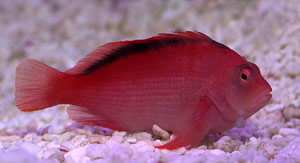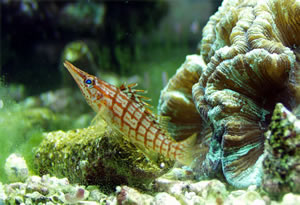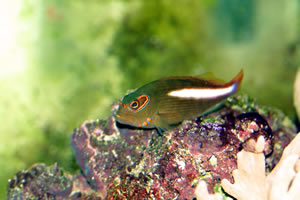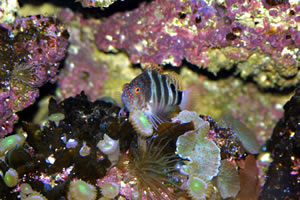|
This month I’ll dive into the world of
Hawkfish. Hawkfish are common imports for the aquarium trade,
and are regularly found throughout the United States in marine
aquarium stores. Often motionless, but yet brimming with personality,
you may find Hawkfish to be an interesting addition to your
aquarium. I am hopeful this article will help you discern
whether a Hawkfish is right for you.
Meet the Family
“Hawkfish” is the common name that is given to a group of
fish that are from the Family Cirrhitidae. Within this family
are nine genera, and 34 species (see list). Four of the genera
contain only one species.
Cirrhitidae:
·
Amblycirrhitus
o
bimacula
o
earnshawi
o
indicus
o
oxyrhynchos
o
pinos
o
unimacula
o
wilhelmi
·
Cirrhitichthys
o
aprinus
o
aureus
o
bleekeri
o
calliurus
o
falco
o
guichenoti
o
maculatus
o
oxycephalus
·
Cirrhitops
o
fasciatus
o
hubbardi
|
·
Cirrhitus
o
albopunctatus
o
atlanticus
o
pinnulatus
o
punctatus
o
rivulatus
o
splendens
·
Cyprinocirrhites
o
polyactis
·
Isocirrhitus
o
sexfasciatus
·
Neocirrhites
o
armatus
·
Oxycirrhitus
o
typus
·
Paracirrhites
o
amblycephalus
o
arcatus
o
bicolor
o
forsteri
o
hemistictus
o
nisus
o
xanthus
Catalog
of Fishes
|
Some characteristics which are common to
all of these fish are the cirri, or hair-like tufts of tissue,
that are present on the top of each of the 10 dorsal spines
and behind the nostrils. All Hawkfish also have 14 rays in
the pectoral fins, a single, crenated dorsal fin, 26 – 28
vertebrae, two spines on the operculum, and lack an air bladder
(Fishbase).
Lastly, all Hawkfish start life as females and transform into
males when needed (Donaldson, 1989).
In the Wild
Hawkfish can be found throughout the world’s
oceans. Most inhabit the Indo-Pacific, with only three species:
Amblycirrhitus indicus, Amblycirrhitus earnshawi,
and Amblycirrhitus pinos, coming from the Atlantic.
Of those, only Amblycirrhitus pinos can be found in
the Caribbean (Catalog
of Fishes).
Most Hawkfish are shallow water fish, rarely
found deeper than 100 feet. Due to the lack of an air bladder,
they sink when they are not swimming. Thus, they will spend
their entire lives perched on substrate or corals. Much like
their namesakes perched high up in treetops, Hawkfish constantly
scan for food. When they spot a possible meal, they quickly
dart from their resting spot and capture their prey. Usually,
the retreat back to the resting spot is as quick as the attack
on the prey.
A variety of prey will fall victim to
Hawkfish. Depending on the species, they will either feed
on a variety of small crustaceans, larger shrimp, crabs, and
even fish. The mouth size is largely responsible for the prey a particular Hawkfish
will hunt. Naturally, the larger the mouth is, the larger
the prey it can eat.
Male Hawkfish will defend a territory that
usually includes at least two, and up to seven, females, although
a few species have been noted to form pairs, usually when
females are short in supply. The size of the territory is
dependent on the number of females in the harem. The search
for a partner begins prior to sunset, with the male visiting
each of his females looking for gravid females. He then returns
to the gravid females prior to total darkness, performing
for only one particular female at a time. The male, using
his snout, nudges the female. Sitting on the female follows,
and finally he quivers his body. Once accepted by the female,
the pair will swim from their perches and release the eggs
and sperm into the water column. When finished, the male
moves onto the next gravid female, while the female looks
for the nearest resting spot (Donaldson, 1990). The pelagic
eggs are assumed to develop into larvae, which are planktonic
for weeks. This may be the primary cause for the widespread
distribution of the family, as the individual adult fish do
not swim long distances from their territories.
In the Home Aquarium
Of the many species, there are several
species of Hawkfish that do well in a home aquarium. A small
portion of this minority does well in community reef aquariums.
If their needs are met, and certain fish and/or crustaceans
are avoided, harmony can be kept.
|
Fish
|
Will Co-Exist
|
May Co-Exist
|
Will Not Co-Exist
|
Notes
|
|
Angels, Dwarf
|
X
|
|
|
Should do fine provided the Hawkfish is added last.
|
|
Angels, Large
|
X
|
|
|
Should do fine provided the Hawkfish is added last.
|
|
Anthias
|
|
|
X
|
Anthias generally require a peaceful aquarium.
|
|
Assessors
|
|
|
X
|
Hawkfish may attack, and possibly consume assessors.
|
|
Basses
|
X
|
|
|
Should do fine provided the Hawkfish is added last.
|
|
Batfish
|
|
X
|
|
Hawkfish may attack the passive batfishes.
|
|
Blennies
|
|
|
X
|
Most blennies are defenseless against Hawkfish attacks.
|
|
Boxfishes
|
|
|
X
|
Hawkfish will most likely harass boxfish.
|
|
Butterflies
|
X
|
|
|
Should do fine provided the Hawkfish is added last.
|
|
Cardinals
|
|
|
X
|
Hawkfish may attack cardinals.
|
|
Catfish
|
X
|
|
|
Should do fine provided the Hawkfish is added last.
|
|
Comet
|
|
X
|
|
The Comet will most likely remain hidden the majority
of the time.
|
|
Cowfish
|
|
|
X
|
Cowfish will most likely be harassed.
|
|
Damsels
|
|
X
|
|
Some adult damsels will be able to defend themselves,
or may even harass smaller Hawkfish.
|
|
Dottybacks
|
X
|
|
|
Should do fine provided the Hawkfish is added last.
|
|
Dragonets
|
|
X
|
|
Generally dragonets are ignored, but some overly aggressive
Hawkfish may attack them.
|
|
Drums
|
|
|
X
|
Drums require peaceful tankmates.
|
|
Eels
|
X
|
|
|
Should do fine provided the Hawkfish is added last.
|
|
Filefish
|
|
|
X
|
Aggressive tankmates are best avoided with Filefish.
|
|
Frogfish
|
|
|
X
|
Large frogfish may consume small Hawks.
|
|
Goatfish
|
|
|
X
|
Goatfish require non-aggressive tankmates.
|
|
Gobies
|
|
|
X
|
Gobies will be harassed or even consumed by Hawkfish.
|
|
Grammas
|
|
X
|
|
Grammas will be reclusive and hide; may get harassed.
|
|
Groupers
|
|
X
|
|
Some groupers can get large enough to consume Hawkfish
|
|
Hamlets
|
|
X
|
|
Hamlets may suffer from repeated attacks from the Hawkfish.
|
|
Hawkfish
|
|
X
|
|
Can co-exist in larger tanks.
|
|
Jawfish
|
|
X
|
|
Once the jawfish is settled in, they may co-exist.
Otherwise, expect to see less of your jawfish.
|
|
Lionfish
|
X
|
|
|
Should do fine provided the Hawkfish is added last.
|
|
Parrotfish
|
X
|
|
|
Should do fine provided the Hawkfish is added last.
|
|
Pineapple Fish
|
|
X
|
|
Larger, more aggressive hawks can harass pineapple
fish.
|
|
Pipefish
|
|
|
X
|
Do not mix. Hawks can easily kill a pipefish.
|
|
Puffers
|
|
X
|
|
The slow moving puffer is a large target for attacks.
|
|
Rabbitfish
|
X
|
|
|
Should do fine provided the Hawkfish is added last.
|
|
Sand Perches
|
|
|
X
|
May fight over the same hiding spots.
|
|
Scorpionfish
|
|
|
|
Larger adult scorpions may consume smaller hawks.
|
|
Seahorses
|
|
|
X
|
Hawkfish will out compete seahorses for food; May attack
seahorses.
|
|
Snappers
|
|
X
|
|
Most snappers can get large enough to consume Hawkfish.
|
|
Soapfishes
|
|
X
|
|
Soapfish will try to swallow smaller Hawkfish.
|
|
Soldierfish
|
|
X
|
|
Hawkfish may pester Soldierfish.
|
|
Spinecheeks
|
|
|
X
|
Hawkfish are too aggressive for the Spinecheeks.
|
|
Squirrelfish
|
|
X
|
|
The more aggressive Hawkfish could pose a problem.
|
|
Surgeonfish
|
X
|
|
|
Should do fine provided the Hawkfish is added last.
|
|
Sweetlips
|
|
X
|
|
The hawkfish may be too aggressive for Sweetlips.
|
|
Tilefish
|
X
|
|
|
Should do fine provided the Hawkfish is added last.
|
|
Toadfish
|
|
|
X
|
Can consume small Hawkfish.
|
|
Triggerfish
|
|
X
|
|
A toss-up. Could go either way. Some triggers should
be kept by themselves.
|
|
Waspfish
|
|
|
X
|
Waspfish are best kept by themselves.
|
|
Wrasses
|
|
X
|
|
Some wrasses may get picked on.
|
The most important consideration pertaining to Hawkfish is a suitable
resting spot. The particular resting spot will vary
from species to species. Some species may prefer a
particular coral for perching, while others may simply choose
the sandbed.
Supplying
a sandbed or a place to perch doesn’t seem so difficult thus
far, does it? Well, in regards to caring for Hawkfish,
it doesn’t get much harder, either. They are particularly
resistant to disease, and readily eat most aquarium foods
offered. Any marine-based fish foods geared towards
carnivores will suffice. Lighting is also a non-factor,
since Hawkfish are found throughout the reef depths. Hawkfish
are fairly “bulletproof.”
A difficult aspect of keeping Hawkfish
is selecting suitable tank mates. Hawkfish can be intolerant
of some fish, and careful consideration and good judgment
should be used when deciding on tank mates. In all instances,
the Hawkfish should be the last fish added to the tank. Otherwise,
the Hawkfish will constantly harass any newcomer to the point
of death. The silver lining to the Hawkfish harassing the
newcomer is that it allows you time to remove the newcomer.
In other cases, the Hawkfish will simply eat the newcomer,
affording no time to save the new addition a.k.a. expensive
meal.
Decorative shrimp should be avoided
with Hawkfish. In most cases the Hawkfish will kill
and/or consume the shrimp. Sessile invertebrates are
not at risk of attack, but the Hawkfish may choose certain corals
as a desired resting spot. Clams, stony, and soft corals
can be irritated by a Hawkfish’s constant perching.
In the aquarium, Hawkfish can be kept in
pairs or even harems. In all instances the dominant fish
in the harem, the male, is the largest fish in the group (Baensch,
1994). Therefore, if a harem is preferred, the aquarist should
acquire a group of the smallest size fish possible, and one
that is noticeably larger, and add them at the same time.
Even if this larger fish is a female, it will shortly make
the change to become a male in the presence of the group of
smaller females. Females may squabble a little, but if two
fish continue to fight after introduction, it should be assumed
you have acquired two males. In this instance, I recommend
that the smaller of the two fish be removed and to try again
with another smaller fish, this time with the hope of acquiring
a female.
Captive spawning of Hawkfish has only occurred
on a few occasions. No fry have ever been developed and,
thus, captive raised Hawkfish are not available.
Meet the Species
Not all Hawkfish make good aquarium inhabitants.
I’ll concentrate primarily on those that are good candidates
for the home aquarium.
The first up is Cirrhitichthys falco,
or the Falco Hawkfish. It originates from the West Pacific
and is usually found around 30 feet to 60 feet deep. Reaching
only three inches in length, it is a safer choice for community
aquariums than most other Hawkfish. It has a small mouth
and larger prey cannot be consumed. Don’t be misled, however,
as they have been known to attack and kill smaller fish, shrimp,
and newcomers. When present in a harem, the male will usually
rest below, rather than above, the group of females it defends
(Baensch, 1994).
Another Cirrhitichthys, C. aprinus,
frequently shows up in the aquarium trade. Commonly called
the Threadfin Hawk, it will reach up to five inches in length.
A favorite resting spot for this species is among sponges
and tunicates of various species. It can be found in the
wild from Southern Japan southward to the Great Barrier Reef
at depths ranging anywhere from 15 feet to 130 feet. Males
have been noted to defend a territory of 25m2 (Coral Realm).
|
|
|
Cirrhitichthys aprinus enjoying
a good vantage point. They can take on many color variations,
but always have a round spot behind the eye.
|
The last Cirrhitichthys that is
regularly imported for the hobby is C. oxycephalus,
sometimes called the Coral or Pixy Hawkfish. Individuals
can barely reach over 3” in length; yet can display a nasty
attitude towards tank mates. As noted with many of the other
Hawkfish, small fish and decorative shrimp should be avoided
to prevent them from becoming a Hawkfish meal. In its natural
habitat it rests primarily on Porites and Pocillopora,
and regularly resides at the base of the coral, rather than
the branches (Coral
Realm).
One of the most popular Hawkfish is the
Flame Hawkfish, or Neocirrihites armatus. Its bright
red coloration quickly grabs the attention of most onlookers.
The Flame Hawkfish is also a good choice for reef aquariums
that are devoid of shrimp. It is considered an obligatory
coral dweller, and generally prefers Pocillopora and
Stylophora spp. (Donaldson, 1989). In aquaria, it
has, on occasion, been known to turn over crabs and snails
and rip them from their shells, mimicking its natural tendencies.
Try to keep it well fed and this behavior should be limited
in the home aquarium. It is a shallow water fish, usually
not found beneath 40 feet. You can expect this fish to be
slightly less outgoing than other Hawkfish.
 |
|
Neocirrhites armatus resting
comfortably on the sandbed.
|
One other Hawkfish is almost equally as
popular as Neocirrihites armatus -- the Long-nosed
Hawkfish, Oxycirrhites typus. Its popularity is due
to its irregular shape, and its suitability for aquariums.
As the name implies, this fish has extra long, thin jaws.
This long mouth allows the fish to reach into small crevices
to capture and remove shrimp. Pulling snails from their shells
is also made easier. It is found deeper than most other aquarium-suitable
Hawkfish, sometimes as deep as 300 feet. More commonly, however,
it is found around 100 feet (Lieske, 1996). Aquarium specimens
are imported from Sri Lanka (Baensch, 1994), though they are
found throughout the Indo-Pacific. Try to keep pairs, as
any two specimens will usually pair up. Spawning is restricted
by the height of most home aquariums. The need for the fish
to rise high off of their substrate during courtship does
not allow them to spawn in any but the tallest of home aquariums.
The Long-nose Hawkfish reaches five inches in length, and
prefers gorgonians and black corals as its resting spot.
 |
|
Oxycirrhites typus assuming
the postion.
|
A Hawkfish that is common in the wild,
but not common in home aquariums, is Paracirrhites arcatus,
or the Arc-eyed Hawkfish. As the name indicates, this fish
has an arc coloration directly behind its eye. This arc is
always orange, red, and blue. It also has three orange bands
on light blue backgrounds on the lower portion of the gill
plate. However, different background color variations can
be found at different depths; red, black, or olive, or any
combination of those colors has been noted (Coral
Realm). This fish reaches almost six inches in length
and is commonly found throughout depths ranging from 1 foot
to 100 feet, though individuals have been spotted as deep
as 300 feet. It is most commonly found resting on the outer
branches of Pocillopora, Acropora, and Stylophora corals.
Unlike most Hawkfish that regularly feed from the water column,
the Arc-eyed Hawkfish primarily feeds from the reef floor.
Crabs and shrimp are the most common dietary items.
 |
|
The georgeous Arc-Eyed
hawkfish in a home aquarium.
|
A. pinos, one of the hawkfishes
representing the Atlantic, is also one of the smaller hawkfishes.
It barely reaches 4 inches in length, and can be initially
shy when introduced. The shyness will wear off, and it will
begin to sit in more open areas. It has a smaller mouth than
most hawkfishes, so it can be kept with smaller fish. Shrimp
are still at risk, however. It is not regularly available
in the aquarium trade, but should not be considered rare either.
 |
|
Amblycirrhitus pinos surveys
its surroundings.
|
Summary
If you don’t mind your tank being absent
of shrimp or snails, a few Hawkfish will do well and can make
excellent additions for your tank of moderately aggressive
fish. Overall size of the fish, tank mates, and aquarium
are the most important considerations besides an aquarium
free from the potential prey items of shrimp, snails, and
small fish.
|

